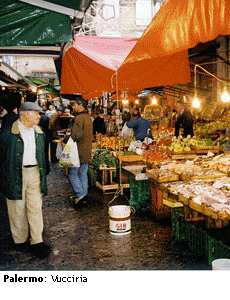|
Palermo’s origins date back to the period between the 8th and the
6th century B.C., when the Phoenicians colonized the area that
was previously inhabited by Sicans, Cretans and the Elimi.After being
contested for a long period between Rome and Carthage during the Punic
wars, the city of
Paleopolis
was placed under Roman rule (254 B.C.).
After several attacks by various barbaric populations, the city then became
a part of the Byzantine
Empire, which governed it
for about three centuries, until 831.
The Arabs took over from the Byzantines and under their rule, Palermo
enjoyed a period of splendor and prosperity. Art and economics were
developed immensely, the first thanks to the influence of Arab culture and
the latter through intense trading with the main Italian ports. Palermo
increased its prestige by building mosques, luxurious palaces and wonderful
gardens.

The Arabs ruled until 1072 when the
Normans
succeeded in gaining possession of the city after a long siege, and thus
began a new era during which the population spread out throughout the
island. Under Norman rule, Palermo was allowed a fair amount of autonomy,
while in the city, palaces and monuments that were the symbols of this
crossroads of culture, such as the Cappella Palatina (Palatine
Chapel) and the Cathedral - Duomo in Monreale were built.
Palermo passed into the hands of the Swabians and Frederick II after
the Normans: in this period, art and literature were developed even further,
culminating in the setting up of the Sicilian School of Poets.
Under the French king, Charles of Anjou, Palermo lost a great deal of
its autonomy, but the people rebelled, and started up the war of the
Sicilian Vespers (1282) that continued for twenty years and which was
intended to throw out the French from the island.
Spanish dominion (1400 - 1700) saw the beginning of a peaceful period
for this much contested city that had been in the hands of various countries
over the centuries. Palermo was once again the capital and the town’s
buildings and monuments were renewed. Various religious orders, which were
increasingly powerful, set up a large number of churches and convents. This
was a period of pomp and opulence for the clergy and the aristocracy, but
was also one of poverty and pestilence for the people, whose rebellions were
often put down without the sparing of blood.
After a brief interval under the Sabaudo family Dynasty (1713 - 1718) and
then under the Austrians (1718 - 1735), Palermo and Sicily were once again
returned to the Spanish, and became the Autonomous State of the
Kingdom of Naples.
When the Bourbon family decreed that the autonomy granted should be
repealed, the whole of Sicily rose up (1820 and 1848) and finally in 1860,
when Garibaldi and the thousand landed at
Marsala,
Palermo won its freedom, and then annexed itself to the Kingdom of Italy
in 1870.
Outside
the city:
|